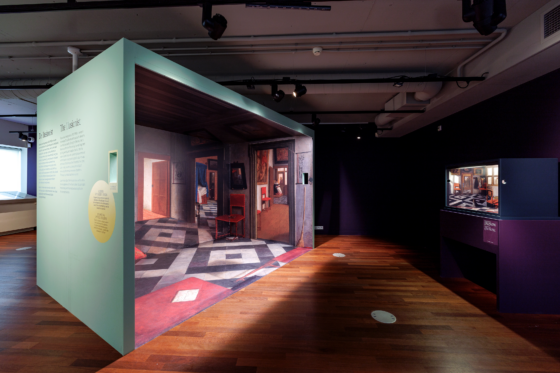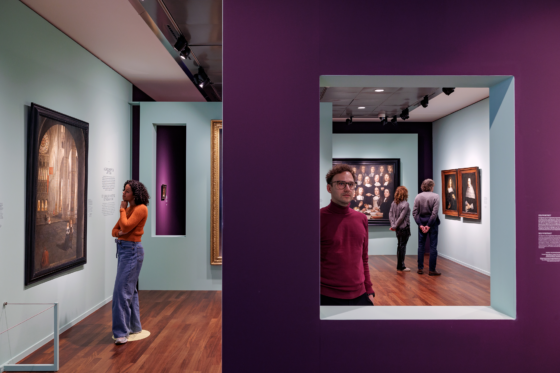Spotlight on Rembrandt’s pupil: “illusionist” van Hoogstraten
Senay Boztas
A man sticks his head out of a window. On the sill below him, a tiny leaf threatens to fall.
This painting by Rembrandt’s most successful pupil Samuel van Hoogstraten is the centrepiece of a new exhibition at the Rembrandthuis Museum – a show entitled “The Illusionist”.
Although he is hardly known nowadays, during the 17th century, Van Hoogstraten was even more successful than Rembrandt. He travelled Europe, wowing Ferdinand III, Archduke of Austria, in Vienna with his trompe l’oeil technique in that painting, Old Man at a Window.
He tried his luck in London, creating portraits of the rich and famous and a “curious perspective box” peepshow cabinet where viewers could look at a scene from different angles, as though they were artists. Towards the end of his life, he created a celebrated book on painting technique, Introduction to the High School of the Art of Painting.
But his own artwork – which revolved around a fascination with illusion – has been largely overlooked by history, according to Milou Halbesma, director of the Rembrandthuis. “Maybe you hear the name Samuel van Hoogstraten and think – who’s that?” she said, at a press opening of the exhibition.
“Van Hoogstraten is a favourite of art historians and many artists, but really is not well enough known amongst the public at large,” she said. “It is fantastic that from Rembrandt’s oeuvre and amongst his pupils, there are still things that you can present that the public doesn’t know.”

Illusion
Working with the Kunsthistorisches Museum in Vienna and the Netherlands Institute for Art History in The Hague (RKD), the Rembrandthuis aims to do something to change this perception. The Illusionist exhibition runs from February until May 4, and curators are also working on a complete online survey of all of Van Hoogstraten’s work, which will soon be available on the RKD website.
On the top floor of the museum, a replica of Van Hoogstraten’s peepshow cabinet has been created alongside a life-size room that you can step inside. In two other rooms, Van Hoogstraten’s work is compared with that of his painter father and Rembrandt – who for five years was his teacher, in this very building in Amsterdam, where Rembrandt lived and worked.
Epco Runia, head of the collection at the Rembrandthuis, said that the exhibition aimed to give a global idea of the artist. “He’s a painter where you think – oh, yes, he wrote a book on art history, he made paintings of 17th century letter racks, but then you look at the work and you see portraits, a landscape here and there, architecture, a still life: there’s everything,” he said. “But what it has in common is the way the visible world is portrayed as realistically as possible, as alluringly as possible and preferably with a visual deceit. Illusionism is the common thread.”
The key work – on loan from Vienna, which wowed the court of the time – is the Old Man at a Window. Shown unframed, to emphasize the painting’s three-dimensionality, the man’s head seems to emerge from a gallery wall, above an astonishingly realistic feather, a little glass bottle and the leaf – ready to be blown off the sill by a gust of wind.

Golden medal
Leonore van Sloten, one of the curators, said that the Austrian archduke was so blown away by the work that he gave the artist a golden medal – something he portrayed in other works, such as a series of letter racks, where the trendy, moneyed citizens of the 17th century would display their letters.
Van Hoogstraten travelled Europe and the UK, with successful commissions for portraits and scenes, before returning to his home town of Dordrecht, a wealthy and highly socially successful painter. He would even pass students on to his own former master, Rembrandt, who by 1656 had gone bankrupt, sold this house and died in poverty.
David de Witt, senior curator, said some art historians believed that there was some bad blood between the two, especially as Rembrandt’s loose style fell from fashion. Van Hoogstraten’s 1678 book, published shortly before his death, criticised Rembrandt for his dislike of stiff, “elegant” poses and “excessive” naturalism.
“Rembrandt’s reputation rose in the 19th century,” said de Witt. “In the 18th century, it was thought that he didn’t paint well, and wasn’t a classicist. Only in the second half of the 19th century, with the rise of impressionism, did Rembrandt become the big hero.”
But now, he believes, it is time for Van Hoogstraten to emerge from the shadows of the past too.
The Illusionist is on at the Rembrandthuis Museum in Amsterdam until May 4
Thank you for donating to DutchNews.nl.
We could not provide the Dutch News service, and keep it free of charge, without the generous support of our readers. Your donations allow us to report on issues you tell us matter, and provide you with a summary of the most important Dutch news each day.
Make a donation